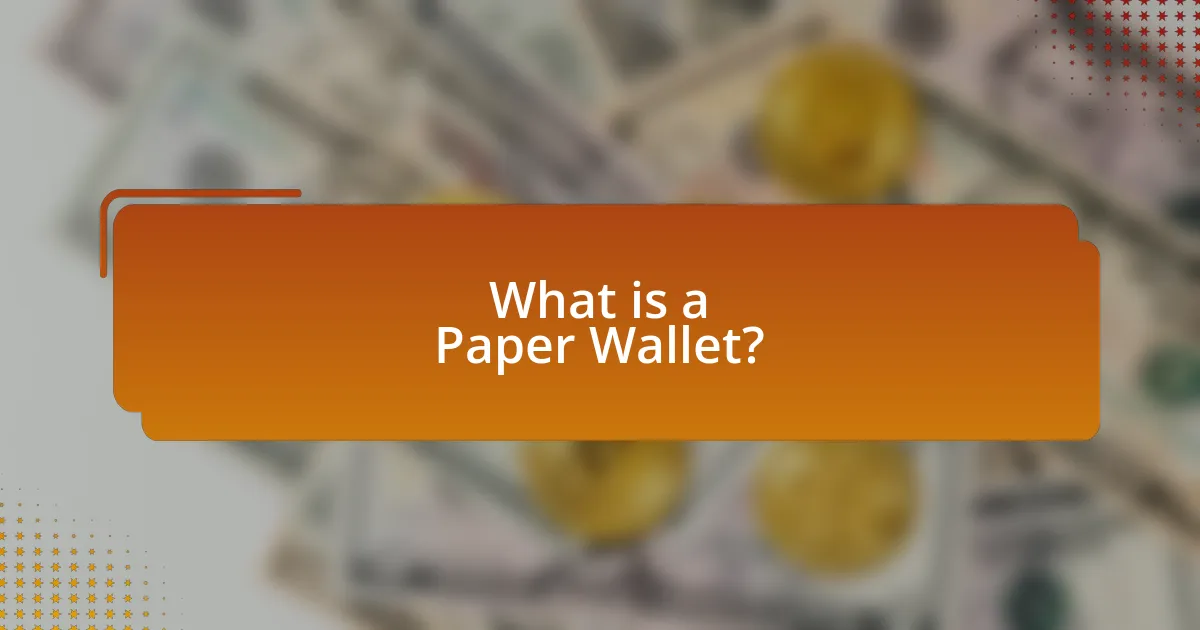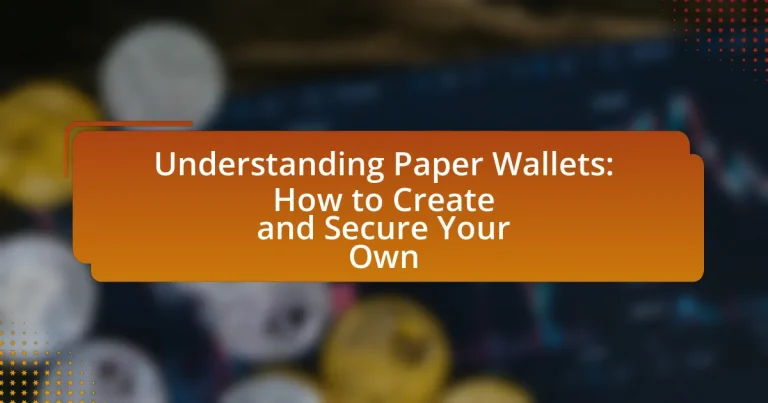A paper wallet is a physical document that securely stores a cryptocurrency address and its corresponding private key, allowing users to keep their digital assets offline and protected from online threats. This article provides a comprehensive overview of paper wallets, detailing their functionality, advantages, and the steps involved in creating and securing one. Key components such as public and private keys, QR codes, and best practices for storage and management are discussed, along with precautions to avoid common pitfalls. Additionally, the article addresses how to recover funds from a compromised wallet and emphasizes the importance of maintaining confidentiality and security throughout the process.

What is a Paper Wallet?
A paper wallet is a physical document that contains a cryptocurrency address and its corresponding private key, allowing users to store their digital assets offline. This method enhances security by protecting the keys from online threats, as they are not stored on a computer or server. Paper wallets are typically generated using secure, offline tools to ensure that the private keys remain confidential and are less susceptible to hacking.
How does a Paper Wallet function in cryptocurrency storage?
A paper wallet functions in cryptocurrency storage by providing a physical medium to store a user’s public and private keys, which are essential for accessing and managing cryptocurrency assets. The public key allows others to send cryptocurrency to the wallet, while the private key is required to authorize transactions and access the funds.
When a user generates a paper wallet, they typically use a secure, offline method to create the keys, ensuring that they are not exposed to online threats. The generated keys are then printed on paper, often accompanied by a QR code for easy scanning. This method of storage is considered cold storage, meaning it is not connected to the internet, which significantly reduces the risk of hacking or theft.
The effectiveness of paper wallets is supported by their ability to remain secure as long as the physical paper is kept safe from damage or loss. Users must ensure that the paper wallet is stored in a secure location, as anyone with access to the private key can control the associated cryptocurrency.
What are the key components of a Paper Wallet?
The key components of a paper wallet are the public key, private key, and QR codes representing both keys. The public key allows others to send cryptocurrency to the wallet, while the private key is essential for accessing and managing the funds stored in the wallet. QR codes facilitate easy scanning for transactions, enhancing usability. Each component must be securely printed and stored to prevent unauthorized access, as the security of a paper wallet relies on the confidentiality of the private key.
How does the generation of a Paper Wallet work?
The generation of a paper wallet involves creating a physical document that contains a cryptocurrency address and its corresponding private key. This process typically uses a secure, offline wallet generator to ensure that the private key is not exposed to the internet, thus minimizing the risk of hacking.
To generate a paper wallet, users often visit a reputable paper wallet generator website, which creates a new public and private key pair. The keys are then printed on paper, often with QR codes for easy scanning. The security of this method relies on the generator being used in a secure environment, ideally offline, to prevent any potential malware from capturing the private key during the generation process.
The effectiveness of paper wallets as a secure storage method is supported by the fact that they are immune to online attacks, as the keys are stored physically rather than digitally.
What are the advantages of using a Paper Wallet?
The advantages of using a paper wallet include enhanced security, offline storage, and ease of use. Paper wallets store private keys in a physical format, making them immune to online hacking attempts. This offline nature significantly reduces the risk of theft associated with digital wallets. Additionally, paper wallets are simple to create and can be generated without the need for complex software, allowing users to manage their cryptocurrency easily. The lack of reliance on electronic devices further ensures that the keys remain safe from malware and other cyber threats.
How does a Paper Wallet enhance security compared to digital wallets?
A paper wallet enhances security compared to digital wallets by storing cryptocurrency offline, which eliminates exposure to online hacking threats. Digital wallets, being connected to the internet, are vulnerable to malware, phishing attacks, and other cyber threats that can compromise private keys. In contrast, a paper wallet generates a public and private key pair that is printed on paper, ensuring that the keys are not stored digitally and are immune to online attacks. This method of storage significantly reduces the risk of unauthorized access, as long as the paper wallet is kept in a secure physical location.
What cost benefits does a Paper Wallet provide?
A paper wallet provides significant cost benefits primarily through its zero transaction fees for storing cryptocurrencies. Unlike digital wallets that may incur fees for transactions or maintenance, a paper wallet requires no ongoing costs once created. Additionally, it eliminates the risk of online hacking, which can lead to financial losses, thus saving potential recovery costs. The simplicity of a paper wallet also means that users do not need to invest in expensive hardware wallets or pay for software solutions, making it a cost-effective option for securely storing cryptocurrencies.

How can you create your own Paper Wallet?
To create your own paper wallet, first generate a new cryptocurrency wallet using a secure, offline wallet generator like Bitaddress.org or WalletGenerator.net. These platforms allow you to create a wallet without being connected to the internet, minimizing the risk of exposure to online threats. After generating the wallet, print the page that contains your public and private keys. Ensure that the printer is not connected to the internet to maintain security. Finally, store the printed paper wallet in a safe place, as it is essential to keep it secure from physical damage or theft. This method is widely recognized for its effectiveness in safeguarding cryptocurrency assets.
What steps are involved in generating a Paper Wallet?
To generate a paper wallet, follow these steps: First, select a reputable paper wallet generator, such as Bitaddress.org or WalletGenerator.net. Next, ensure your computer is offline to prevent exposure to malware. Then, generate a new wallet by moving your mouse or typing random characters to create entropy. After the wallet is generated, print the wallet securely, ensuring that the printer is not connected to the internet. Finally, store the printed paper wallet in a safe place, as it contains your private and public keys. These steps ensure the secure creation of a paper wallet, minimizing the risk of theft or loss.
What tools or software are recommended for creating a Paper Wallet?
To create a paper wallet, recommended tools include Bitaddress.org and WalletGenerator.net. Bitaddress.org is an open-source tool that allows users to generate Bitcoin paper wallets offline, ensuring security from online threats. WalletGenerator.net offers a similar service for multiple cryptocurrencies and can also be used offline to enhance security. Both tools provide a straightforward interface for generating secure private and public keys, which are essential for creating a paper wallet.
How do you ensure the randomness and security of your keys?
To ensure the randomness and security of keys, utilize a cryptographically secure random number generator (CSPRNG) to create keys. CSPRNGs, such as those based on algorithms like Fortuna or Yarrow, provide high entropy and unpredictability, making it extremely difficult for attackers to guess the keys. Additionally, storing the keys in a secure environment, such as an offline paper wallet, further protects them from unauthorized access and potential breaches. This method has been validated by cryptographic standards, which emphasize the importance of using secure random number generation techniques to maintain key integrity and confidentiality.
What precautions should you take when creating a Paper Wallet?
When creating a paper wallet, ensure you generate it in a secure, offline environment to prevent exposure to malware or online threats. Use a trusted, open-source wallet generator, and verify its authenticity by checking the code or using a reputable source. Additionally, print the wallet using a secure printer and avoid saving any digital copies to minimize the risk of theft. Store the paper wallet in a safe location, such as a safe deposit box, to protect it from physical damage or loss. These precautions are essential to safeguard your cryptocurrency assets effectively.
How can you avoid common pitfalls during the creation process?
To avoid common pitfalls during the creation process of paper wallets, ensure you use a secure and offline environment for generating the wallet. This minimizes the risk of exposure to malware or online threats. Additionally, verify the integrity of the software used for wallet generation by downloading it from reputable sources and checking for any known vulnerabilities. According to a study by the University of Cambridge, using compromised software can lead to significant security breaches, emphasizing the importance of using trusted tools. Furthermore, always print the wallet on a secure printer and store it in a safe location to prevent physical theft or damage.
What security measures should be implemented during the generation?
During the generation of paper wallets, it is crucial to implement security measures such as using an offline computer, ensuring a secure environment, and utilizing trusted software. An offline computer minimizes the risk of malware and hacking, as it is not connected to the internet during the generation process. A secure environment, free from surveillance and potential intruders, further protects sensitive information. Additionally, using trusted software, preferably open-source, ensures that the code can be audited for security vulnerabilities, reducing the risk of generating compromised wallets. These measures collectively enhance the security of the paper wallet generation process, safeguarding the user’s cryptocurrency assets.

How do you secure and store your Paper Wallet?
To secure and store your paper wallet, first, ensure it is generated in a secure environment, preferably offline, to prevent exposure to malware. After printing the wallet, store it in a safe place, such as a safe deposit box or a fireproof safe, to protect it from physical damage or theft. Additionally, consider making multiple copies and storing them in different secure locations to mitigate the risk of loss. The importance of these measures is underscored by the fact that paper wallets are vulnerable to physical destruction and theft, making secure storage essential for safeguarding your cryptocurrency assets.
What are the best practices for storing a Paper Wallet safely?
The best practices for storing a paper wallet safely include keeping it in a secure, dry location, such as a safe or a safety deposit box, to prevent physical damage and unauthorized access. Additionally, users should create multiple copies of the paper wallet and store them in different secure locations to mitigate the risk of loss. It is also crucial to avoid digital storage methods, as scanning or photographing the wallet can expose it to online threats. Furthermore, using a fireproof and waterproof container can protect the wallet from environmental hazards. These practices are essential because paper wallets are vulnerable to theft, loss, and damage, making secure storage critical for safeguarding cryptocurrency assets.
How can you protect your Paper Wallet from physical damage?
To protect your paper wallet from physical damage, store it in a waterproof and fireproof safe or container. This method ensures that the wallet is shielded from water, fire, and physical wear. Additionally, using a laminate or plastic sleeve can provide extra protection against tears and spills. According to the Federal Emergency Management Agency (FEMA), safeguarding important documents in such conditions can significantly reduce the risk of loss due to environmental factors.
What methods can be used to ensure the Paper Wallet remains confidential?
To ensure a paper wallet remains confidential, it is essential to generate it in a secure environment, such as an offline computer or a dedicated device that is not connected to the internet. This minimizes the risk of exposure to malware or hacking attempts. Additionally, users should print the wallet using a secure printer and store it in a safe location, such as a safe deposit box or a fireproof safe, to prevent unauthorized access or physical theft. Using a strong password for any digital backups and encrypting the wallet information can further enhance confidentiality. These methods are validated by security best practices in cryptocurrency management, which emphasize the importance of offline generation and secure storage to protect sensitive information.
What should you do if your Paper Wallet is compromised?
If your paper wallet is compromised, immediately transfer all funds to a new wallet. This action is crucial because a compromised paper wallet means that someone else may have access to your private keys, allowing them to steal your cryptocurrency. To ensure the security of your assets, create a new wallet, preferably a hardware wallet or a secure software wallet, and generate a new set of keys. After transferring your funds, securely destroy the compromised paper wallet to prevent any future access.
How can you recover funds from a compromised Paper Wallet?
To recover funds from a compromised paper wallet, immediately transfer the remaining funds to a secure wallet. This action is crucial because a compromised paper wallet means that the private key has been exposed, allowing unauthorized access to the funds. After transferring the funds, generate a new paper wallet using a secure method, ensuring that the private key is never exposed to potential threats. This process is validated by the fact that once a private key is compromised, the security of the associated funds is irreversibly at risk.
What steps should you take to prevent future compromises?
To prevent future compromises of paper wallets, ensure you generate them in a secure environment, ideally offline, to avoid exposure to malware. Use a trusted, open-source wallet generator and verify its integrity through checksums. After generating the wallet, print it using a secure printer, and store the physical copy in a safe location, such as a safe deposit box. Additionally, avoid sharing the wallet’s private key and consider using a backup method, like a second paper wallet, stored separately. These steps are crucial as they minimize the risk of unauthorized access and loss of funds, which have been documented in various security studies highlighting the vulnerabilities of digital wallets when not properly secured.
What are some common mistakes to avoid with Paper Wallets?
Common mistakes to avoid with paper wallets include failing to generate them in a secure environment, neglecting to back up the wallet, and not using a reliable printer. Generating a paper wallet on an insecure device can expose private keys to malware, while not backing up the wallet can lead to irreversible loss of funds if the paper is damaged or lost. Additionally, using a printer connected to the internet can compromise the wallet’s security, as it may leave traces of the private key.
How can you identify and rectify errors in the creation process?
To identify and rectify errors in the creation process of paper wallets, one should conduct thorough testing and validation of each step involved. This includes verifying the accuracy of the generated private and public keys, ensuring that the wallet is printed correctly without any distortions, and checking that the QR codes are scannable. Additionally, using software tools to cross-reference the generated keys with known secure wallets can help identify discrepancies. For instance, a study by the University of Cambridge highlighted that improper key generation can lead to vulnerabilities, emphasizing the importance of using reliable software for wallet creation. By implementing these measures, one can effectively identify and rectify errors in the paper wallet creation process.
What misconceptions about Paper Wallets should you be aware of?
One misconception about paper wallets is that they are completely secure and immune to hacking. While paper wallets do provide a cold storage solution, they are vulnerable to physical damage, loss, or theft. For instance, if a paper wallet is exposed to water or fire, the private keys can be destroyed, rendering the wallet useless. Additionally, if someone gains physical access to the paper wallet, they can easily steal the funds. Therefore, while paper wallets can be a secure method of storing cryptocurrencies when created and handled properly, they are not infallible and require careful management to ensure their safety.
What tips can help you effectively use and manage your Paper Wallet?
To effectively use and manage your Paper Wallet, ensure you store it in a secure, fireproof, and waterproof location. This protects against physical damage and theft, which are common risks associated with paper wallets. Additionally, make multiple copies of your paper wallet and store them in different secure locations to mitigate the risk of loss. It is also crucial to avoid sharing your private keys or QR codes with anyone, as this can lead to unauthorized access to your funds. Furthermore, regularly check the balance of your wallet using a secure method to ensure that your funds are intact. These practices are essential for maintaining the security and accessibility of your cryptocurrency stored in a paper wallet.


